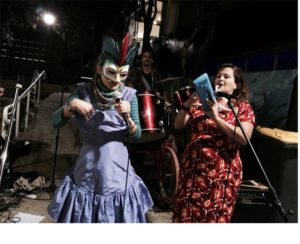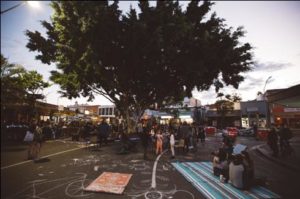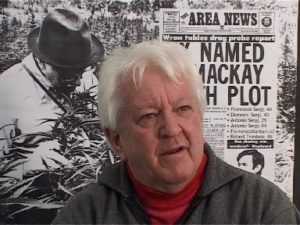http://www.abc.net.au/radionational/programs/ockhamsrazor/was-australia-intended-as-a-hemp-colony3f/4240480#transcript
Robyn Williams: There’s as book on my desk which features the glossy portrait of a man you know in all his finery, red sash, large medallion, buttoned great coat and the face – all authority, determined jaw and imposing brow; for it is Sir Joseph Banks, whose name resounds all over Australia from Bankstown to banksias representing our firm link to a scientific tradition from the very beginnings of the European colony. But then there’s the title of the book Sir Joseph Banks and the Question of Hemp. Can this be serious? Was Joe a hippy? What’s the story? Well here for your edification and mine is historian Dr John Jiggens – make of it what you will.
John Jiggens: In 1995 I helped organise an Australian tour for Jack Herer, the author of a book called The Emperor Wears No Clothes, which was subtitled the true authoritative history of cannabis hemp. Herer was an amateur historian and a crusader against marijuana prohibition who had discovered that marijuana was also this plant called hemp, which had once been an extremely important plant, but was now banned because it was said to be an evil drug plant. During his research Herer discovered the founding fathers of the US, George Washington and Thomas Jefferson, had grown hemp, while the sixth president, John Quincy Adams, had even written an essay on the growing of hemp in Russia when he was Consul there.
Herer concluded that hemp had been the most important plant on the planet and he developed the theory that marijuana prohibition had come about as a back door attempt to make hemp illegal. Hemp had been banned because of the economic competition it offered to the plastic industry, to paper from trees and to new synthetic fibres like Nylon.
As a historian I found Herer’s history of cannabis remarkable, yet he was such a cannabis enthusiast that some of his conclusion seemed far-fetched. I set to work researching the history of hemp in Australia and I was surprised to discover that Herer’s claims about hemp’s historical importance were justified. From reading the documents about the founding of Australia and from reading books like Blainey’s The Tyranny of Distance I came to see how central concerns about hemp were in Britain in 1786 when the decision for New South Wales was made.
The history we had been taught at school that convicts were the original reason for settlement was simply a cover story. New South Wales was intended as a hemp colony. For Europeans in the Age of Sail, cannabis did not mean marijuana; it meant hemp, the long vegetable fibre extracted from the stem of the European hemp plant. The word canvas comes from the Dutch word for cannabis. To fit out a first rate man-of-war required 80 tons of hemp for sails, cables and rigging and to produce that much hemp 320 acres of Cannabis sativa had to be grown. Because it was the basis for sail and rope, hemp was as central to sea power and empire in the Age of Sail as oil is in our era.
Just as the oil industry provides the technological basis for our commerce and our warfare, 200 years ago hemp was basic to the technology of war and trade. As oil supplies and alternatives to oil occupy some of the greatest minds of our era, 200 years ago, Sir Joseph Banks was preoccupied with hemp supplies and alternatives to hemp.
In the course of my research I became aware that Sir Joseph Banks played a central role in planning the colony of New South Wales and that Banks was deeply interested in hemp. Just as the founding fathers of the US were hemp enthusiasts, so was the founding father of Australia. My breakthrough came while reading Joseph Maiden’s biography, Sir Joseph Banks – The Father of Australia, where I discovered a reference to a file in the Kew Banks’ collection called Hemp 1764-1810. For many years I have been sifting through this file, laboriously deciphering Banks’ gout-crippled handwriting, trying to understand the history it contained. Having long suspected Banks’ central role in British hemp policy I was pleased to discover that the file more than confirmed my view.
The conventional explanation for the British settlement of New South Wales was that Britain needed to find an alternative outlet for disposing of its burgeoning criminal classes. Since the British sent out convicts on the First Fleet it seemed reasonable to believe that they simply wanted Australia as a gaol. Yet the cost of establishing a convict settlement halfway round the world was so great that historians like K. M. Dallas suggested that ‘the dumping of convicts view’ was too simple and that there were hidden reasons.
In Sir Joseph Banks and the Question of Hemp I suggest that the hidden reason behind the settlement in New South Wales was the need for a replacement hemp colony, rather than a replacement prison. My analysis of the hemp trade between 1776 and 1815 shows that the need for a hemp colony was a recurring theme in British strategic thinking during the Georgian era.
Banks’ hemp file was my entry point to the question of hemp. In 1797 at the height of the French Revolutionary Wars Sir Joseph Banks was appointed to the Privy Council Committee of Trade, the main instrument of the British state dealing with trade and colonies. At this crucial point in the struggle with France, Banks assumed charge of hemp policies for the British Empire. The file, ‘Hemp 1764 to1810’ contained Banks’ working papers on hemp during this period. The major document in this file was a report on the hemp question that Banks delivered to the Committee of Trade in 1802.
An important reason for the differing opinions about the founding of Australia is that we lack substantial documentation to explain the intent of the British government in 1786. Apart from the 15 paragraphs in the Heads of a Plan for Botany Bay there is an historical vacuum. One of the 15 paragraphs in the Heads of a Plan is concerned with the importance of the New Zealand hemp plant for naval supplies. There is substantial corroborative evidence in the journals and the letters of the early governors and officers to support the hemp colony theory; however this paragraph has been the major evidence that British government concerns over hemp prompted the Botany Bay decision.
This explains why Banks’ Privy Council file on hemp and the Indian Office files on the Indian hemp experiment are so important. What these files disclosed was a second British hemp experiment in the Georgian era in India, but a much better documented hemp experiment, with the question of hemp comprehensively addressed in Banks’ report to the Committee of Trade and in George Sinclair’s memorial to the East India Company. Although there is a dearth of documentation on the New South Wales hemp experiment, these files on the Indian hemp experiment contained hundreds of pages of discussion and analysis of the hemp question. Because of the short interval between the two hemp experiments, it can be confidently inferred that the benefits that were advanced for the Indian hemp trial were identical to those that prompted the New South Wales hemp trial.
Banks’ scheme to solve the question of hemp with cannabis plantations in India was undone by an error in cannabis taxonomy. Although he was informed that hemp grew well in India, the cannabis of India, Cannabis indica, was different from Cannabis sativa; Indian hemp or ganga had been developed as an inebriant, not a fibre crop. Because they looked similar, the British assumed the plants were the same and that the Indians were foolishly ignorant of ganga’s quality as a hemp. And so the British grew plantations of ganga for hemp in India, unaware that they were trying to turn dope into rope.
But ganga, Cannabis indica, is a separate species to hemp, it is not a fibre crop just as hemp is not a drug crop. As well as revealing British hemp policies, Banks’ hemp file records his meeting with the Indian hemp plant. The existence of a drug variety of cannabis was puzzling to Banks and his investigators, because hemp does not have the same intoxicating qualities as ganga. Having procured a source of the drug Banks supplied the poet Coleridge with a quantity of Indian hemp. Not only was Banks a substantial cultivator of the drug cannabis, he was also the first recorded supplier of drug cannabis in England!
The species question in cannabis is contentious, but over the centuries the polytypic theory of cannabis, the idea that there are several cannabis species, has developed. First argued by Lamarck, Banks’ contemporary, and extended by the Russians in the early 20th century, the polytypic theory contends that there are three species of the genus cannabis, sativa, indica and ruderalis. This view is reinforced by the disappointment of Banks’ Indian hemp experiment, which failed because the British incorrectly assumed that the Indian hemp plant ganga was the same as European hemp.
In revealing how this error was made, I hope to clarify the cannabis debate and allow for more sensible cannabis laws. At the moment hemp, Cannabis sativa, is regulated as though it were ganga, Cannabis indica. We ban hemp on the pretext that it is marijuana. As a consequence the growing of hemp is illegal in many jurisdictions and in others it is so heavily regulated that the industry can barely survive. I hope that this disambiguation of hemp and marijuana will aid the revival of this important plant.
In its day hemp was the most important vegetable on the planet. During the age of oil hemp has been dethroned, slandered and banned. The resulting mineralisation of the economy has been a major cause of growth of greenhouse gasses. The re-vegetabilisation of the economy that a revival of the hemp industry will bring offers us the chance to change this.
Robyn Williams: Dr John Jiggens in Brisbane maybe he wants us to return to sail, it’ll be more serene, unless there’s a storm of course, but should take a little longer. His book is Sir Joseph Banks and the Question of Hemp. I’m Robyn Williams
References:
Herer, Jack The Emperor Wears No Clothes, Ah Ha Publishing, Van Nuys, CA, 1985
Hemp 1764-1810, Kew Banks Collection
Dallas M The First Settlement in Australia, considered in relation to sea-power in world politics THRA P&P, 1952, No. 3,12,
Hemp and Flax 1790-1805,IOR/H/375
Heads of a Plan for Botany Bay, Historical Records of New South Wales, Volume 1 part 2
Schultes, Richard Evans, Klein, William M, Plowman, Timothy and Lockwood Tom E. Cannabis: An example of Taxonomic Neglect (Cambridge, Mass: Harvard Botanic Museum, 1974
To order book go to Sir Joseph Banks








